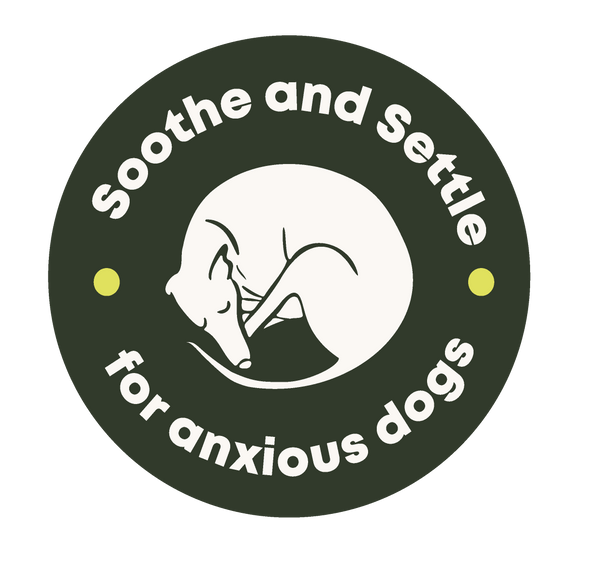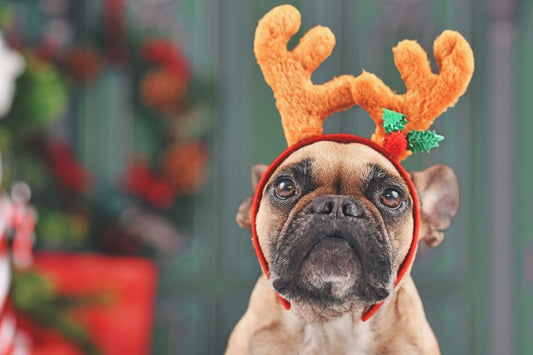
How to Keep Your Dog Calm During a Storm
Share
A fear of loud noises is very common for dogs. In fact, it is estimated that almost half of all dogs are frightened of loud noises, with the top culprits being thunderstorms, fireworks, vacuum cleaners, alarms and sirens.
If you share your life with an anxious or reactive pup, this can be extra difficult, including in the lead-up to and during a storm.
The good news is that if you’re wondering how to keep your dog calm during a storm, training, calming products, and a safe, cosy space can all help!
Whether your dog shows mild unease or severe panic during storms, this guide explains why dogs are afraid of storms, including why they can sense when one is due, and how you can keep them calm before, during and after.
Are Dogs Afraid of Storms?
Why are dogs afraid of storms? Essentially, dogs often experience fear during storms as a result of overwhelming stimuli. Thunder, flashing, winds and sudden rain are all triggers which can cause real distress.
Signs your dog is anxious or scared can range from panting, trembling, shaking, restlessness and pacing to loss of appetite, going to the toilet inside, destructive behaviour and trying to escape.
Recognising these signs is the first step toward helping your dog overcome its fear, rather than getting worse over time (which can happen without proper management).

Some examples of how your dog might behave when anxious, via Dogs Trust UK.
Dogs who have had negative experiences during storms may develop lasting phobias. A single traumatic event—such as being caught outside in a sudden storm, experiencing a nearby lightning strike, or being left alone during particularly violent weather—can create lasting associations between storms and fear.
In addition, puppies who weren't exposed to storm sounds or loud noises during their critical socialisation period are more likely to develop fears later in life.
Can Dogs Sense When a Storm Is Coming?
Yes, it is thought that dogs can sense when a storm is coming due to their heightened senses.
The reasons why dogs can sense when a storm is coming include:
- Acute Hearing: Dogs can perceive low-frequency rumbles of distant thunder long before humans hear them, thanks to their broader hearing range.
- Olfactory Detection: A dog's sense of smell is between 10,000 and 100,000 times more sensitive than humans. This extraordinary sense of smell allows dogs to detect rain-scented molecules or the ozone that often accompanies lightning long before these elements arrive at their location.
- Barometric Pressure: A falling atmospheric pressure often precedes storms. Dogs can detect minute drops in barometric pressure that occur before storms, similar to how some people feel "weather headaches" before storms.
- Static: Dogs appear sensitive to static electricity buildup in the atmosphere before and during storms. Some researchers believe the static electricity generated by lightning may cause uncomfortable tingling or miniature shocks through a dog's fur, particularly for dogs with thick or double coats.
These sensory abilities explain why many dogs appear to "sense" storms before any visible signs; they're tuned into subtle environmental cues that humans just aren't.

It is thought that dogs can sense when a storm is coming due to their heightened senses.
How to Keep Your Dog Calm During a Storm
If your dog shows signs of fear around thunderstorms, and you know a storm is on its way, here’s what you can do to help your dog get settled beforehand.
1. Avoid Walks
Because dogs can sense when a storm is coming, going outside might make them nervous. Plus, if a storm catches you during your walk, there's a chance your dog might become anxious or reactive (and sometimes escape). For this reason, hold off on walks during this time.
If you do get caught, remain calm. Dogs are exceptional at reading human body language and emotional states. If you display anxiety or stress about your dog's reaction to the storm, you may inadvertently reinforce their fear.
2. Reduce Impact
You can make the environment feel safer for your pup by blocking out the noise. You can keep your dog inside, shut the windows, and play music or white noise to drown out the sound.
Closing curtains or blinds can help reduce lightning flashes that often precede thunderclaps. For particularly sensitive dogs, consider using blackout curtains to create a more consistent visual environment.
3. Create a Safe Haven
In addition to reducing impact, you can designate a safe, comfortable space in your home where your dog can retreat during loud noises. Place an item of your clothing in your dog's bed, along with any of their favourite toys and blankets, to help them feel safe and comfortable. Consider using a crate covered with a heavy blanket for dogs already crate-trained.
Never force your dog into their safe space—instead, make it inviting with treats and comforting items.

Bonus Tip: A microwavable heat bag for dogs provides additional warmth that can comfort your dog in stressful situations.
4. Use a Hush Muff
Using ear or head coverings can help to reduce exposure to loud noises and calm your dog down.
At Soothe and Settle, we have created The Hush Muff, an anti-anxiety head covering with a unique, registered design that is tailored to fit around your dog's head.
As well as muffling the impact of sudden loud noises, it wraps your pet in a gentle embrace for an additional sense of comfort (the pressure can help to trigger a calming effect).
The Hush Muff attenuates 6–12 dB at lower frequencies (rumble, traffic), and 12–18 dB at higher sounds like fireworks or high-pitched thunder, meaning perceived loudness can be halved or even quartered.
Its versatile application extends beyond just storms; it is a useful tool for lots of stress-inducing scenarios, including travel and visits to the vets.

We recommend that you introduce the Hush Muff well before storm season to create positive associations, including taking it on and off with treats and praise, and with short wearing sessions during calm periods.
6. Try Supplements
When appropriate and under veterinary guidance, certain supplements can support calm during thunderstorms and other anxiety-inducing situations without prescription medication. These products typically contain natural ingredients with mild sedative or anxiety-reducing properties.
Natural herbs like chamomile, valerian root, passionflower and lavender have calming effects and can be taken as supplements.
We recommend Dorwest Herbs. Their Valerian Compound, in particular, can calm your stressed, hyperactive or frightened pet without making them dopey or sleepy. In fact, it is widely used for agility and show dogs when they need to be alert and focused, but calm.
Read our full guide on How to Choose Dog Supplements for more information.
7. Training
Desensitisation and counterconditioning are powerful behaviour modification techniques used to help dogs overcome fear. The goal is to expose your dog to the feared stimulus (in this case, loud noises) at a low intensity while pairing it with something positive, such as treats or playtime.
Better yet, combining these tools creates layers of reliability and reduces storm-related anxiety more effectively than any single method.

Use desensitisation and counterconditioning together to help dogs overcome storm fears safely and effectively.
Conclusion
To sum up, if you're wondering how to keep your dog calm during a storm, you'll need patience, understanding, and often a multi-faceted approach that addresses both immediate comfort and long-term anxiety reduction.
Amidst all the strategies and tools, it’s essential to recognise that your dog is an individual. From subtle body language to changes in routine, your pup’s cues will tell you the most about how they're coping with a storm.
If your dog is still struggling after trying these tips, don't hesitate to consult professionals, including trainers, veterinarians, or veterinary behaviourists, for personalised guidance.
How Can We Help
At Soothe and Settle, we want to change the way we treat anxiety in dogs. Providing pooches with safe, research-backed stress relievers that make a real difference is what we’re passionate about - including our anti-anxiety Hush Muff and wheat bags.
To discover more about our mission and get regular doggy updates, subscribe to our mailing list below.
Why not try out The Hush Muff? The original anti-anxiety muff is designed to help dogs prone to anxiety or nervousness in stressful situations, including storms and other loud noises.
It's available in over 10 different designs, and works for small to extra large dogs of all breeds - check out our size guide for more information on which one is right for your pup.




